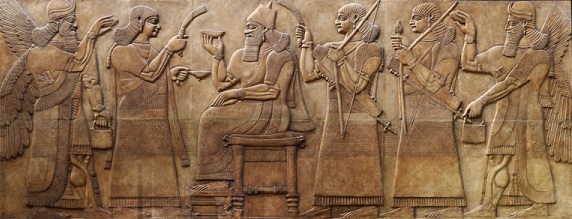

Assyrian art and architecture refers to the forms of art and architecture developed by the ancient Assyrian civilization that existed in Mesopotamia (present-day Iraq) between the 25th century BC and the 7th century BC. The Assyrian Empire was one of the most powerful empires of the ancient world, and its art and architecture reflect this.
The most famous examples of Assyrian art are the stone reliefs that adorned the palaces of the Assyrian kings. The art also includes statues, seals, and metalwork, many of which were highly detailed and depicted figures such as gods, kings, and animals. The architecture of the Assyrian Empire is also notable, with the city of Nineveh being known for its towering ziggurat and impressive palaces and temples.

Ancient relef from Kalhu (Nimurid, Iraq) with Ashurnasirpal II king of Assyria on the throne with the Cup of sacrifice and is surrounded by a winged genius- patrons and courtiers
The Assyrian Empire was one of the most powerful empires of the ancient world, and it flourished from the 25th century BC to the 7th century BC.
The Assyrians built a number of impressive palaces, many of which were decorated with intricate carvings and reliefs.
These carvings and reliefs were often used to depict scenes of warfare, hunting, and royal ceremonies.
The palace art of the Assyrians was highly stylized and often featured large, muscular figures with exaggerated features.
The most famous example of Assyrian palace art is the reliefs from the palace of Ashurbanipal at Nineveh, which are now housed in the British Museum.
Some of the carvings and reliefs from the palaces of the Assyrians have been found in museums and private collections around the world, but many have been lost to time.
The palace art of the Assyrians also featured intricate cuneiform inscriptions, which provided historical and religious information
The Assyrians were ruled by a series of powerful kings, many of whom were known for their military conquests and their building projects.
The Assyrian kings built a number of impressive cities, including the capital city of Nineveh.
The city of Nineveh was known for its towering ziggurat, which was one of the tallest structures of the ancient world. It was considered as the home of the god of the city and was a symbol of the city's religious and political power.
The city was also home to a number of impressive palaces, temples, and other public buildings, many of which were decorated with elaborate carvings and reliefs.
The city of Nimrud was another major city of the Assyrian empire, it was known for its impressive palace, which was decorated with many reliefs and also for the discovery of the throne of Ashurnasirpal II, which is a notable example of Assyrian metalwork.
The city of Dur-Sharrukin was founded by Sargon II as a new capital, it was also known for its impressive palace and temples.
The Assyrian kings also built several other cities such as Kalhu (Nimrud), Khorsabad, and Dur-Katlimmu.
The cities were fortified with walls and towers, which protected the city from enemy invasions.
The Assyrians were known for their palace art, which featured elaborate carvings and reliefs.
They also created statues, seals, and metalwork, many of which were highly detailed and depicted figures such as gods, kings, and animals.
They liked to depict battles, hunting, and court scenes in their art.
They also liked to depict their gods, goddesses and demons in their art.
They used a variety of materials, such as stone, metal, and clay, to create their art.
They were particularly known for their reliefs, which were often used to decorate the walls of palaces and temples.
Assyrian art was often used to depict the power and wealth of the empire and its rulers.
Many of the carvings and reliefs from the palaces of the Assyrian kings depict scenes of warfare, hunting, and royal ceremonies.
The art also depict the gods and goddesses, demons and monsters that the Assyrians believed in.
The art also depicted scenes from the daily life of the Assyrian people.
The art also served a religious purpose, many of the carvings and reliefs depict religious rituals and ceremonies.
The art also served a propaganda purpose, many of the carvings and reliefs depict the king as a powerful ruler, who defeated his enemies and brought peace and prosperity to the empire.
In conclusion, Assyrian art and architecture were important aspects of the ancient civilization that existed in Mesopotamia. The art and architecture of the Assyrian Empire were characterized by elaborate carvings and reliefs, statues, seals, metalwork, and impressive palaces and temples.
Many of these artworks have been discovered in modern-day Iraq and are now housed in museums around the world, providing us with a glimpse into the past and the rich culture of the ancient Assyrian civilization. The Assyrian art and architecture are a testament to the creativity, skill, and ingenuity of the ancient people who created them and continue to inspire us today.
Q1. How did the Assyrian arts and architecture influence later civilizations?
Ans. The Assyrian arts and architecture had a significant influence on later civilizations, particularly those in the Near East and the Mediterranean region. Its style and techniques were adopted and adapted by the Persians, Greeks, and Romans, who built on the legacy of the Assyrians.
Q2. Are there any notable examples of Assyrian metalwork that have been discovered?
Ans. Yes, several examples of Assyrian metalwork have been discovered, including a gold and silver throne from Nimrud, and a gold and enameled bronze statue of a goddess from the palace of Ashurbanipal.
Q3. What is the significance of the ziggurat in the Assyrian city of Nineveh?
Ans. The ziggurat in the Assyrian city of Nineveh was a massive stepped tower that was used as a temple and was considered the home of the god of the city. It was one of the tallest structures in the ancient world and a symbol of the city's religious and political power.